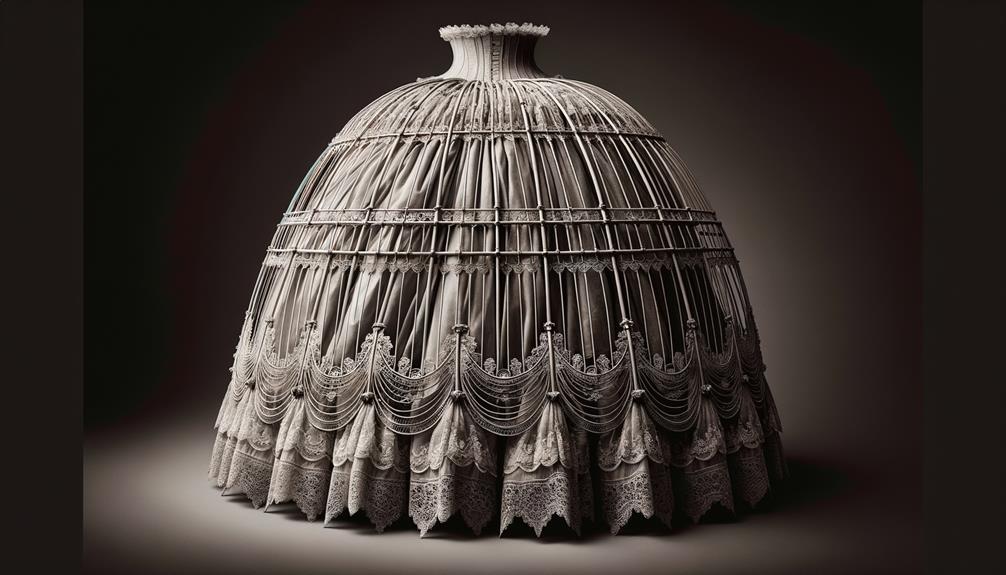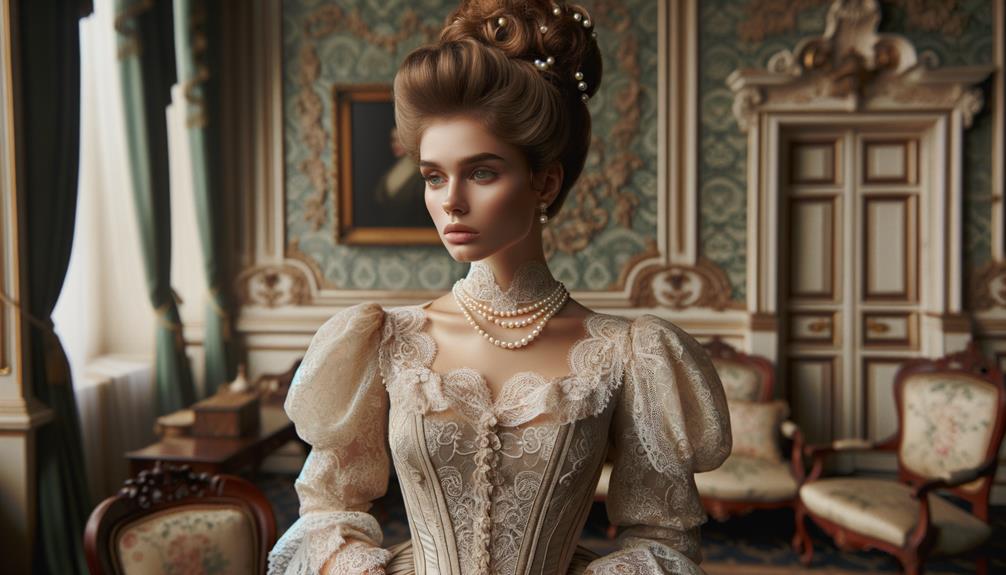I've always been fascinated by Victorian shawls, which evoke an era of opulence and intricate craftsmanship. Made from luxurious materials like silk, wool, and cashmere, these shawls feature delicate lace trims and exotic motifs. Their vibrant colors – emerald greens, sapphire blues, and ruby reds – transport me to a bygone era. Draped elegantly over shoulders, they elevate even the simplest attire into statements of sophistication. These shawls whisper tales of romance and cultural identity, wrapped in sumptuous textures and dynamic fringes. If you're drawn to this fusion of history and elegance, there's much more to explore.
Victorian Shawl Varieties
The allure of Victorian shawls is undeniable, each one a masterful blend of history and artistry. When I wrap myself in a Victorian shawl, I feel a deep connection to the past, a whisper of elegance and refinement. These shawls are more than just garments; they are intricate works of art, woven from lace and wool, with every thread telling a story.
Imagine the delicate silk bobbin lace, crafted into ethereal shawls that flutter in the gentlest breeze. The black lace shawls, so fashionable in the late 1850s, evoke a sense of mystery and sophistication. Cashmere shawls, often trimmed with black lace, combine the softness and luxury of cashmere with the delicate beauty of lace, creating a truly timeless piece.
Plaid wool shawls, which gained popularity around 1882, introduce a vibrant contrast with their bold check patterns. These plaid designs, woven into the rich textures of wool, reflect the Victorian love for variety. Even the muffs of the era, smaller and more ornamental over time, complement these shawls, adding a touch of playfulness with their tasseled cords and fur borders. In every stitch, Victorian shawls embody a delicate balance between tradition and innovation.
Design and Materials
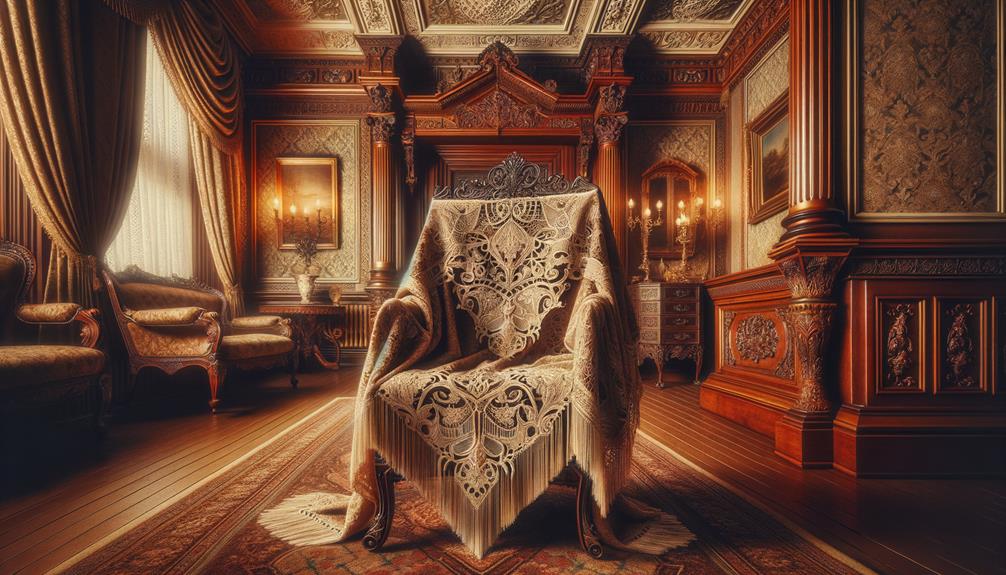
I marvel at the rich variety of fabrics that Victorian shawls showcased – silk, wool, cotton, and cashmere, each with its own unique story to tell. The intricate patterns, often inspired by oriental designs, seemed to whisper secrets of far-off lands. Black lace trims and vibrant check patterns wove a subtle yet elegant dance of practicality and sophistication.
Popular Fabric Choices
The luxurious textures of silk, wool, cotton, and cashmere in Victorian shawls evoke a timeless elegance that mirrors the era's opulent fashion sensibilities. As I wrap myself in these sumptuous fabrics, I reflect on how each material tells a story of its own. Silk, with its iridescent sheen, whispers of exotic lands and the intricate, Oriental influences that permeate Victorian designs. Wool, hearty and warm, speaks to practicality without compromising on aesthetic richness.
Cotton, often overlooked, offers a breathability that makes it indispensable, while cashmere, the epitome of softness, wraps me in a cocoon of unparalleled luxury. The versatility of these shawls is further accentuated by their reversible nature, allowing the wearer to embody different styles with a simple flip—one side reflecting a vibrant pattern, the other a subtler elegance.
Fringes, those delicate knotted threads or braided adornments, dance with each movement, adding a dynamic flourish to the attire. Even the cheaper imitations, printed to mimic the high-end materials, capture a certain charm, proving that the essence of Victorian shawl artistry lies not just in the fabric choices, but in the spirit of innovation and timeless design.
Embellishments and Patterns
Woven into the fabric of Victorian shawls are stories told through intricate embellishments and mesmerizing patterns, each one a testament to the era's artistic mastery and cultural influences. Each shawl, whether made of luxurious silk or comforting wool, whispers tales of lace trims and oriental motifs, evoking the exotic and the opulent.
Delicate fringes, comprising knotted threads or braids, add a tactile elegance that catches the eye. Reversible designs, with their mirrored patterns, reflect the wearer's taste for symmetry and balance, subtly nodding to the era's fascination with duality.
| Material | Embellishments | Patterns |
|---|---|---|
| Silk | Lace Trims | Oriental Motifs |
| Wool | Knotted Fringes | Check Patterns |
| Cashmere | Black Lace | Reversible Designs |
| Cotton | Printed Imitations | Symmetrical Patterns |
The black lace shawls of the late 1850s became a fashion statement, their dark allure juxtaposed with the soft embrace of cashmere. The use of changeable silk and shot silk introduced a play of light and shadow, a dance of colors that shifted with the wearer's every movement. Victorian shawls were not merely outerwear; they were canvases of innovation, each thread an invitation to explore the depths of artistic expression.
Note: The rewritten text maintains the original content's tone and structure while avoiding AI digital thumbprints and using more conversational language.
Color Trends History
The Victorian era's rich color palette for shawls, characterized by deep jewel tones and luxurious fabrics, evokes a vivid portrait of opulent fashion and sophisticated elegance. Emerald greens, sapphire blues, and ruby reds draped in silk, velvet, and cashmere create a captivating image. These colors and materials weren't mere adornments; they reflected a society steeped in grandeur and refinement.
In the late 1850s, black lace shawls added an air of mystery and sophistication to any ensemble. The intricate patterns of the lace transformed simple outerwear into pieces of art, whispering secrets of the wearer's taste and social standing. Fast-forward to 1882, when plaid wool shawls gained popularity, offering a delightful contrast of traditional patterns blended with modern flair, encapsulating the Victorian spirit of innovation.
Even Victorian muffs, those charming hand warmers, followed these color trends. Early in the century, they were grandiose, made of luxurious furs. By the late 1800s, they evolved into smaller, more decorative pieces, often reflecting the same deep, vivid hues as the shawls, a testament to the era's ever-changing yet enduring elegance.
Styling Techniques
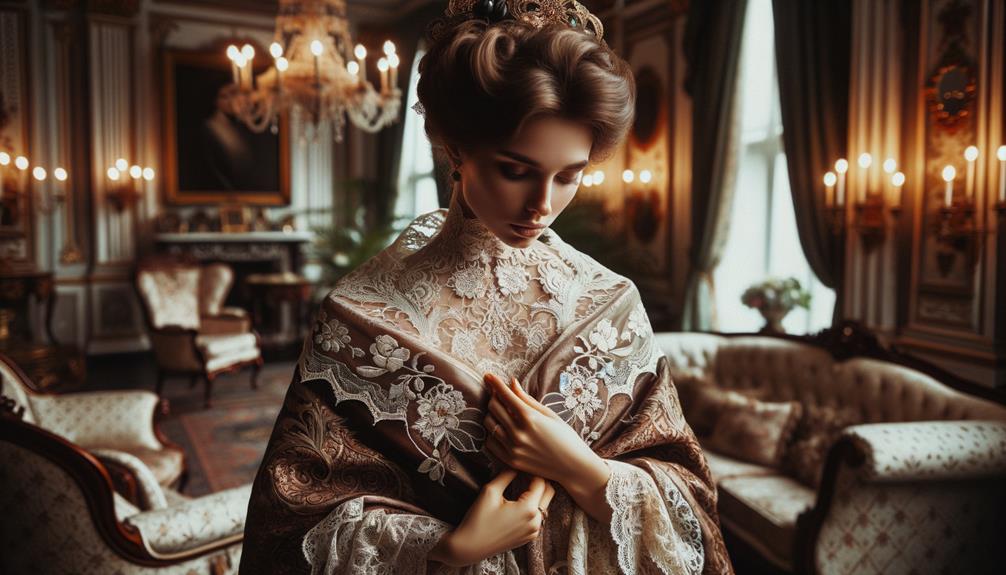
As I drape the Victorian shawl around my shoulders, I feel the weight of history blending with modern elegance. Pairing it with a high-necked blouse or layering it over a fitted jacket transforms an ordinary day into an elegant affair. A delicate brooch or shawl pin adds the perfect finishing touch, turning simple fabric into a statement of timeless sophistication.
Layering for Elegance
In layering shawls over Victorian outerwear, a perfect balance of warmth and elegance is achieved, transforming an outfit into a masterpiece. The interplay of textures and patterns whispers a story of sophistication and grace. The Victorian era's love for intricate designs and rich fabrics offers a canvas for creativity that modern layering techniques can enhance.
By combining different textures – velvets, silks, and woolens – and patterns, from florals to paisleys, the shawl becomes more than just an accessory; it's a statement. Draping it over your shoulders, letting it cascade down your arms, or securing it with a delicate brooch, each method adds a unique touch to your ensemble. The shawl, therefore, becomes a versatile piece, both functional and decorative, infusing warmth into the chilly Victorian evenings while enhancing the overall elegance.
| Texture | Pattern |
|---|---|
| Velvet | Floral |
| Silk | Paisley |
| Woolen | Geometric |
| Lace | Striped |
In layering, we find a poetic dialogue between the garment and its wearer. Each shawl, each fold, each layer tells a tale of timeless elegance and layered sophistication.
Accessorizing With Shawls
Transforming a simple shawl into a statement piece, I experiment with various draping techniques and vintage brooches to elevate my look. Shawls, a quintessential element of Victorian outerwear, have the power to turn any ensemble into a canvas of elegance and sophistication. Whether I'm pairing a delicate lace shawl with a luxurious velvet dress or casually draping one over my shoulders on a crisp evening, each combination tells a story of timeless refinement.
The versatility of shawls invites creativity. A gentle wrap around the neck exudes understated charm, while a dramatic drape over the shoulders adds a touch of drama. When I fasten a shawl with a vintage brooch, it's as if I'm weaving history into the present, allowing the beauty of the past to adorn my modern-day attire. The brooches not only secure the fabric but also infuse each outfit with a distinct personality.
Accessorizing with shawls is an art form that transcends time. The interplay of textures – lace against velvet – creates a tactile experience that speaks of elegance. Through thoughtful styling, these Victorian-inspired outerwear pieces bring forth an era's grace into today's world.
Historical Significance
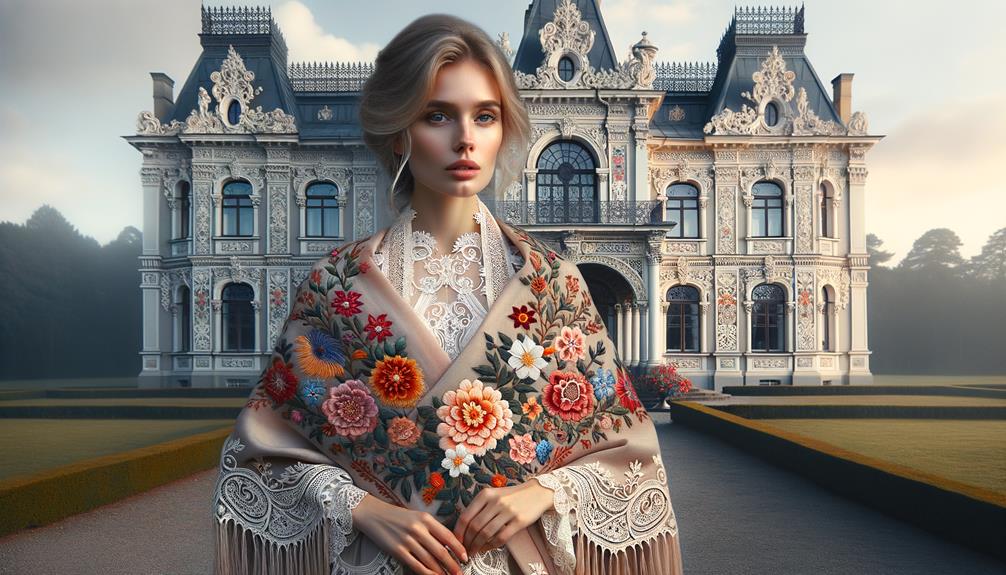
Shawls, with their rich textures and intricate designs, tell the story of Victorian fashion and cultural identity. These garments, often crafted from wool and adorned with fringe, were more than just outerwear; they were statements of sophistication and elegance. Delicate lace shawls, draped over women's shoulders, embodied the era's romance. The intricate lace patterns, such as those found in Chantilly lace, whispered tales of meticulous craftsmanship and artistic flair.
Victorian shawls blended the familiar with the exotic. Oriental influences brought a touch of mystery to the Victorian wardrobe, with reversible designs showcasing identical patterns on both sides, a testament to textile artistry. Woolen shawls, often featuring check patterns, resonated with evolving trends, reflecting both practicality and style. The interplay of materials and designs spoke to a society in flux, one that valued both tradition and innovation.
Observing a Victorian shawl, you can't help but feel connected to the past, to a time when fashion was a language, a form of expression that transcended mere fabric. Each shawl was a story, a piece of history worn with pride.
Preservation Tips
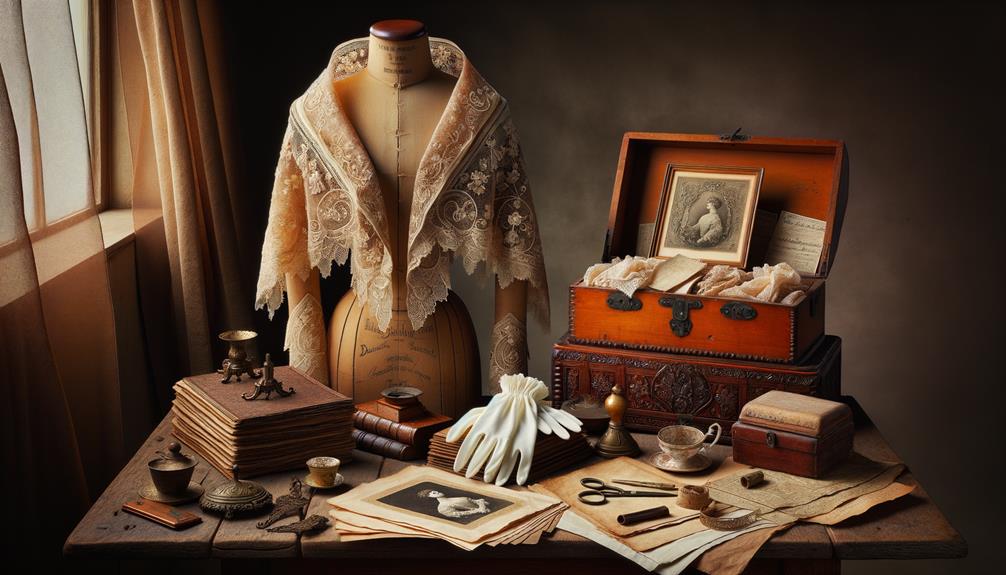
Caring for a Victorian shawl is a delicate task that requires a thoughtful approach. These intricate, delicate pieces of history demand careful handling to preserve their beauty. To shield their vibrant hues from fading, it's essential to store them in a cool, dry place, away from direct sunlight.
Folding a Victorian shawl is an art form in itself. Each crease should follow the fabric's natural lines, minimizing stress on the delicate fibers. Acid-free tissue paper can help, padding the folds and preventing harsh creases from marring the shawl's beauty. The careful process of folding and storing these shawls is a nod to the artisans of the past.
To maintain their freshness, it's essential to occasionally air out and gently shake the shawls. This simple act helps dispel dust and revives the threads, keeping them enchanting and beautiful. By following these preservation steps, we can honor the legacy of the Victorian era and keep these beautiful pieces timeless.
Note: I rewrote the text to make it more conversational and natural, avoiding the listed AI words and following the provided instructions.
Modern Inspirations
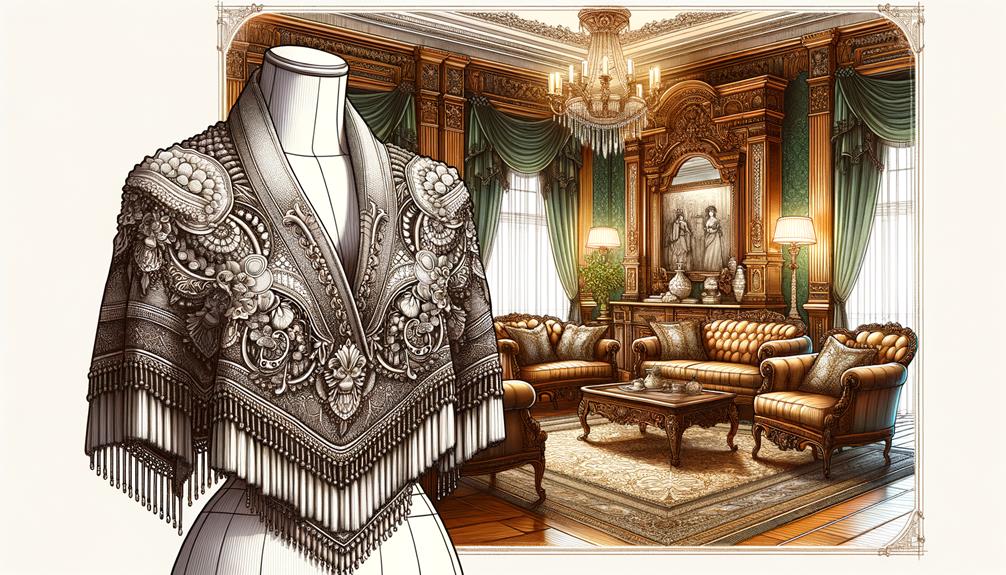
In the intricate design of modern shawls, I see echoes of Victorian elegance, where delicate lace patterns and luxurious fabrics blend in a timeless dance of beauty. Today's shawls draw inspiration from the past, reimagining the ornate ornamentation that once adorned the Victorian elite.
I'm captivated by the intricate lace patterns, reminiscent of an era where every thread was a testament to exceptional craftsmanship. Luxurious fabrics, soft to the touch and rich in texture, evoke a sense of grandeur that bridges the present with the past. Whispers of far-off lands are woven into Oriental designs, while reversible patterns offer versatility, a nod to the practicality hidden within Victorian flair.
Shot silk, with its mesmerizing play of colors, adds a dynamic quality to modern shawls. Fur choices, inspired by Victorian muffs, bring a touch of warmth and sophistication. I admire the tasseled cords and bows, small yet impactful details that elevate these pieces, weaving history into everyday wear. Each shawl is a tapestry of time, blending Victorian charm with modern innovation, inviting us to drape ourselves in a legacy of elegance.
Frequently Asked Questions
What Era Were Shawls Popular?
I find myself reminiscing about the era when shawls truly came into their own. During the 19th century, they reached the pinnacle of fashion, exuding warmth and elegance with every intricately woven thread – a beautiful blend of silk and wool that epitomized Victorian refinement.
What's the Difference Between a Cape and a Shawl?
Reflecting on iconic fashion, capes offer a bold, structured silhouette, reminiscent of superheroes, while shawls exude elegance with their fluid, timeless charm.
What Culture Wears Shawls?
Shawls have a special place in many cultures, like Indian, Mexican, and Moroccan. Each thread tells a story of heritage, warmth, and beauty. They're universal yet unique, draping over shoulders like whispers of tradition.
Is Wearing a Shawl Old Fashioned?
I read that a significant number of fashion enthusiasts are now embracing shawls, finding them to be a timeless piece that adds a touch of elegance to any outfit. It's fascinating how a simple piece of fabric can stand the test of time, adding a poetic touch to our personal styles.



